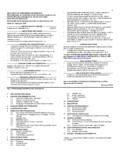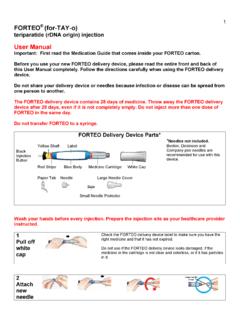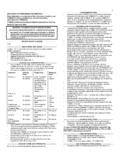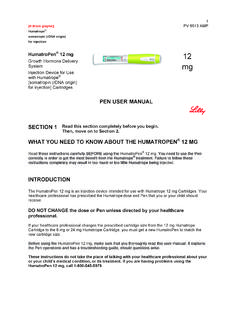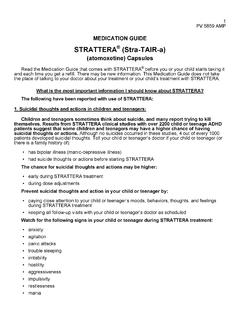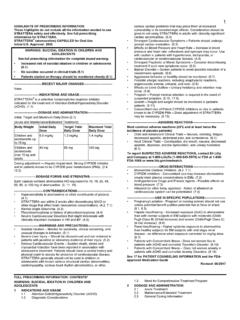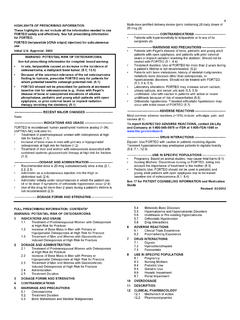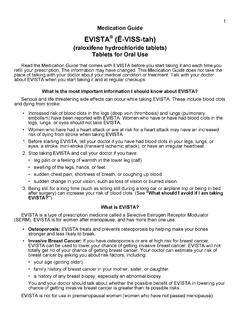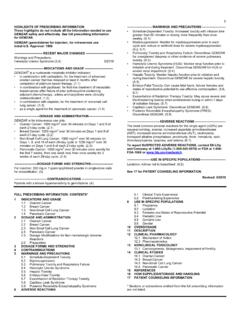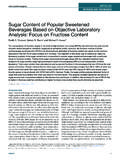Transcription of GLUCAGON FOR INJECTION - Eli Lilly and Company
1 1. INFORMATION FOR THE USER. GLUCAGON . FOR INJECTION . BECOME FAMILIAR WITH THE FOLLOWING INSTRUCTIONS BEFORE AN. EMERGENCY ARISES. DO NOT USE THIS KIT AFTER DATE STAMPED ON THE VIAL. OF GLUCAGON . IF YOU HAVE QUESTIONS CONCERNING THE USE OF THIS. PRODUCT, CONSULT A DOCTOR, NURSE OR PHARMACIST. Make sure that your relatives or close friends know that if you become unconscious, medical assistance must always be sought. GLUCAGON may have been prescribed so that members of your household can give the INJECTION if you become severely hypoglycemic and are unable to take sugar by mouth. If you are unconscious, GLUCAGON can be given while awaiting medical assistance.
2 Show your family members and others where you keep this kit and how to use it. They need to know how to use it before you need it. They can practice giving a shot by giving you your normal insulin shots. It is important that they practice. A person who has never given a shot probably will not be able to do it in an emergency. IMPORTANT. Act quickly. Prolonged unconsciousness may be harmful. These simple instructions will help you give GLUCAGON successfully. Turn patient on his/her side to prevent patient from choking. The contents of the syringe are inactive. You must mix the contents of the syringe with the GLUCAGON in the accompanying bottle before giving INJECTION .
3 (See DIRECTIONS FOR USE. below.). Do not prepare GLUCAGON for INJECTION until you are ready to use it. WARNING: THE PATIENT MAY BE IN A COMA FROM SEVERE. HYPERGLYCEMIA (VERY HIGH BLOOD GLUCOSE) RATHER THAN SEVERE. HYPOGLYCEMIA (VERY LOW BLOOD SUGAR). IN SUCH A CASE, THE PATIENT. WILL NOT RESPOND TO GLUCAGON AND REQUIRES IMMEDIATE MEDICAL. ATTENTION. INDICATIONS FOR USE. Use GLUCAGON to treat insulin coma or insulin reaction resulting from severe hypoglycemia (very low blood sugar). Symptoms of severe hypoglycemia include disorientation, unconsciousness, and seizures or convulsions. Give GLUCAGON if (1) the patient is unconscious (2) the patient is unable to eat sugar or a sugar-sweetened product (3) the patient is having a seizure, or (4) repeated administration of sugar or a sugar-sweetened product such as a regular soft drink or fruit juice does not improve the patient's condition.
4 Milder cases of hypoglycemia should be treated promptly by eating sugar or a sugar-sweetened product. (See INFORMATION. ON HYPOGLYCEMIA below for more information on the symptoms of hypoglycemia.). GLUCAGON is not active when taken orally. DIRECTIONS FOR USE. TO PREPARE GLUCAGON FOR INJECTION . 1. Remove the flip-off seal from the bottle of GLUCAGON . Wipe rubber stopper on bottle with alcohol swab. 2. 2. Remove the needle protector from the syringe, and inject the entire contents of the syringe into the bottle of GLUCAGON . DO NOT REMOVE THE PLASTIC CLIP FROM THE. SYRINGE. Remove syringe from the bottle. 3. Swirl bottle gently until GLUCAGON dissolves completely.
5 GLUCAGON SHOULD NOT. BE USED UNLESS THE SOLUTION IS CLEAR AND OF A WATER-LIKE. CONSISTENCY. TO INJECT GLUCAGON . Use Same Technique as for Injecting Insulin 4. Using the same syringe, hold bottle upside down and, making sure the needle tip remains in solution, gently withdraw all of the solution (1 mg mark on syringe) from bottle. The plastic clip on the syringe will prevent the rubber stopper from being pulled out of the syringe; however, if the plastic plunger rod separates from the rubber stopper, simply reinsert the rod by turning it clockwise. The usual adult dose is 1 mg. For children weighing less than 44 lb (20 kg), give 1/2 adult dose ( mg). For children, withdraw 1/2.
6 Of the solution from the bottle ( mg mark on syringe). DISCARD UNUSED. PORTION. 3. USING THE FOLLOWING DIRECTIONS, INJECT GLUCAGON IMMEDIATELY. AFTER MIXING. 5. Cleanse INJECTION site on buttock, arm, or thigh with alcohol swab. 6. Insert the needle into the loose tissue under the cleansed INJECTION site, and inject all (or 1/2 for children weighing less than 44 lb) of the GLUCAGON solution. Apply light pressure at the INJECTION site, and withdraw the needle. Press an alcohol swab against the INJECTION site. 7. Turn the patient on his/her side. When an unconscious person awakens, he/she may vomit. Turning the patient on his/her side will prevent him/her from choking.
7 8. FEED THE PATIENT AS SOON AS HE/SHE AWAKENS AND IS ABLE TO. SWALLOW. Give the patient a fast-acting source of sugar (such as a regular soft drink or fruit juice) and a long-acting source of sugar (such as crackers and cheese or a meat sandwich). If the patient does not awaken within 15 minutes, give another dose of GLUCAGON and INFORM A DOCTOR OR EMERGENCY SERVICES IMMEDIATELY. 9. Even if the GLUCAGON revives the patient, his/her doctor should be promptly notified. A. doctor should be notified whenever severe hypoglycemic reactions occur. INFORMATION ON HYPOGLYCEMIA. Early symptoms of hypoglycemia (low blood glucose) include: sweating drowsiness dizziness sleep disturbances palpitation anxiety tremor blurred vision hunger slurred speech restlessness depressed mood tingling in the hands, feet, lips, or tongue irritability lightheadedness abnormal behavior inability to concentrate unsteady movement headache personality changes If not treated, the patient may progress to severe hypoglycemia that can include: disorientation seizures unconsciousness death The occurrence of early symptoms calls for prompt and, if necessary, repeated administration of some form of carbohydrate.
8 Patients should always carry a quick source of sugar, such as candy mints or glucose tablets. The prompt treatment of mild hypoglycemic symptoms can prevent severe hypoglycemic reactions. If the patient does not improve or if administration of carbohydrate is impossible, GLUCAGON should be given or the patient should be treated with intravenous glucose at a medical facility. GLUCAGON , a naturally occurring substance produced by the pancreas, is helpful because it enables the patient to produce his/her own blood glucose to correct the hypoglycemia. 4. POSSIBLE PROBLEMS WITH GLUCAGON TREATMENT. Side effects may include nausea and vomiting, a temporary increase in heart rate, and allergic reactions to GLUCAGON or to one of the inactive ingredients in GLUCAGON .
9 If you experience any other reactions which are likely to have been caused by GLUCAGON , please contact your doctor. STORAGE. Store the kit at controlled room temperature between 20 to 25 C (68 to 77 F) before mixing GLUCAGON with the diluent. GLUCAGON that has been mixed with diluent should be used immediately. Discard any unused portion. Solutions should be clear and of a water-like consistency at time of use. Literature revised April 2018. Marketed by: Lilly USA, LLC. Indianapolis, IN 46285, USA. Copyright 1999, 2018, Eli Lilly and Company . All rights reserved. GLU-0002-PPI-20180418.
